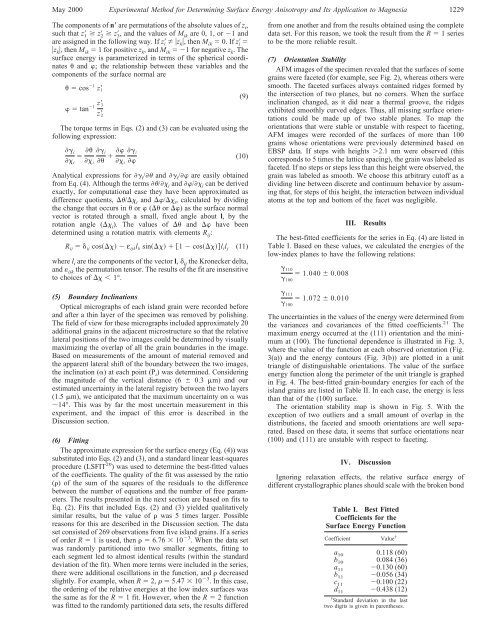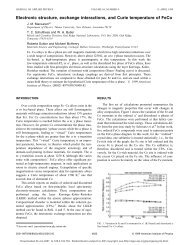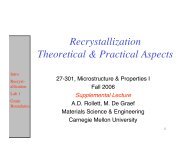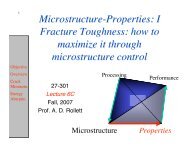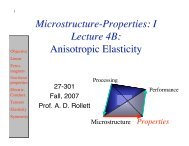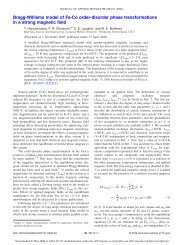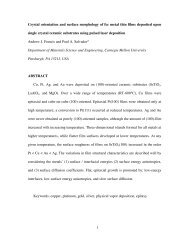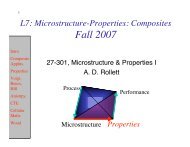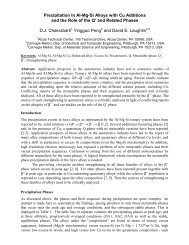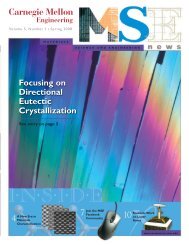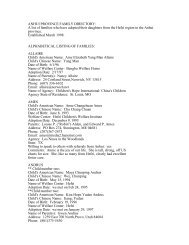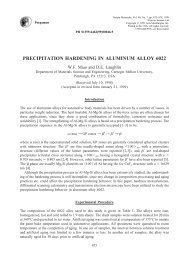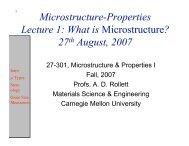Experimental Method for Determining Surface Energy - Materials ...
Experimental Method for Determining Surface Energy - Materials ...
Experimental Method for Determining Surface Energy - Materials ...
Create successful ePaper yourself
Turn your PDF publications into a flip-book with our unique Google optimized e-Paper software.
May 2000 <strong>Experimental</strong> <strong>Method</strong> <strong>for</strong> <strong>Determining</strong> <strong>Surface</strong> <strong>Energy</strong> Anisotropy and Its Application to Magnesia 1229<br />
The components of n are permutations of the absolute values of zi, such that z 1 z 2 z 3, and the values of Mik are 0, 1, or 1 and<br />
are assigned in the following way. If z i zk, then Mik 0. If z i <br />
zk, then Mik 1 <strong>for</strong> positive zk, and Mik 1<strong>for</strong> negative zk. The<br />
surface energy is parameterized in terms of the spherical coordinates<br />
and ; the relationship between these variables and the<br />
components of the surface normal are<br />
cos1 z1 (9)<br />
tan1 z3 z2 The torque terms in Eqs. (2) and (3) can be evaluated using the<br />
following expression:<br />
i i <br />
i<br />
i i <br />
i <br />
(10)<br />
Analytical expressions <strong>for</strong> i/ and i/ are easily obtained<br />
from Eq. (4). Although the terms / i and / i can be derived<br />
exactly, <strong>for</strong> computational ease they have been approximated as<br />
difference quotients, / i and / i, calculated by dividing<br />
the change that occurs in or ( or ) as the surface normal<br />
vector is rotated through a small, fixed angle about l, by the<br />
rotation angle ( i). The values of and have been<br />
determined using a rotation matrix with elements R ij:<br />
R ij ij cos ε ijkl k sin 1 cosl il j<br />
(11)<br />
where l i are the components of the vector l, ij the Kronecker delta,<br />
and ijk the permutation tensor. The results of the fit are insensitive<br />
to choices of 1°.<br />
(5) Boundary Inclinations<br />
Optical micrographs of each island grain were recorded be<strong>for</strong>e<br />
and after a thin layer of the specimen was removed by polishing.<br />
The field of view <strong>for</strong> these micrographs included approximately 20<br />
additional grains in the adjacent microstructure so that the relative<br />
lateral positions of the two images could be determined by visually<br />
maximizing the overlap of all the grain boundaries in the image.<br />
Based on measurements of the amount of material removed and<br />
the apparent lateral shift of the boundary between the two images,<br />
the inclination () at each point (P i) was determined. Considering<br />
the magnitude of the vertical distance (6 0.3 m) and our<br />
estimated uncertainty in the lateral registry between the two layers<br />
(1.5 m), we anticipated that the maximum uncertainty on was<br />
14°. This was by far the most uncertain measurement in this<br />
experiment, and the impact of this error is described in the<br />
Discussion section.<br />
(6) Fitting<br />
The approximate expression <strong>for</strong> the surface energy (Eq. (4)) was<br />
substituted into Eqs. (2) and (3), and a standard linear least-squares<br />
procedure (LSFIT 20 ) was used to determine the best-fitted values<br />
of the coefficients. The quality of the fit was assessed by the ratio<br />
() of the sum of the squares of the residuals to the difference<br />
between the number of equations and the number of free parameters.<br />
The results presented in the next section are based on fits to<br />
Eq. (2). Fits that included Eqs. (2) and (3) yielded qualitatively<br />
similar results, but the value of was 5 times larger. Possible<br />
reasons <strong>for</strong> this are described in the Discussion section. The data<br />
set consisted of 269 observations from five island grains. If a series<br />
of order R 1 is used, then 6.76 10 3 . When the data set<br />
was randomly partitioned into two smaller segments, fitting to<br />
each segment led to almost identical results (within the standard<br />
deviation of the fit). When more terms were included in the series,<br />
there were additional oscillations in the function, and decreased<br />
slightly. For example, when R 2, 5.47 10 3 . In this case,<br />
the ordering of the relative energies at the low index surfaces was<br />
the same as <strong>for</strong> the R 1 fit. However, when the R 2 function<br />
was fitted to the randomly partitioned data sets, the results differed<br />
from one another and from the results obtained using the complete<br />
data set. For this reason, we took the result from the R 1 series<br />
to be the more reliable result.<br />
(7) Orientation Stability<br />
AFM images of the specimen revealed that the surfaces of some<br />
grains were faceted (<strong>for</strong> example, see Fig. 2), whereas others were<br />
smooth. The faceted surfaces always contained ridges <strong>for</strong>med by<br />
the intersection of two planes, but no corners. When the surface<br />
inclination changed, as it did near a thermal groove, the ridges<br />
exhibited smoothly curved edges. Thus, all missing surface orientations<br />
could be made up of two stable planes. To map the<br />
orientations that were stable or unstable with respect to faceting,<br />
AFM images were recorded of the surfaces of more than 100<br />
grains whose orientations were previously determined based on<br />
EBSP data. If steps with heights 2.1 nm were observed (this<br />
corresponds to 5 times the lattice spacing), the grain was labeled as<br />
faceted. If no steps or steps less than this height were observed, the<br />
grain was labeled as smooth. We choose this arbitrary cutoff as a<br />
dividing line between discrete and continuum behavior by assuming<br />
that, <strong>for</strong> steps of this height, the interaction between individual<br />
atoms at the top and bottom of the facet was negligible.<br />
III. Results<br />
The best-fitted coefficients <strong>for</strong> the series in Eq. (4) are listed in<br />
Table I. Based on these values, we calculated the energies of the<br />
low-index planes to have the following relations:<br />
110 100 111 100 1.040 0.008<br />
1.072 0.010<br />
The uncertainties in the values of the energy were determined from<br />
the variances and covariances of the fitted coefficients. 21 The<br />
maximum energy occurred at the (111) orientation and the minimum<br />
at (100). The functional dependence is illustrated in Fig. 3,<br />
where the value of the function at each observed orientation (Fig.<br />
3(a)) and the energy contours (Fig. 3(b)) are plotted in a unit<br />
triangle of distinguishable orientations. The value of the surface<br />
energy function along the perimeter of the unit triangle is graphed<br />
in Fig. 4. The best-fitted grain-boundary energies <strong>for</strong> each of the<br />
island grains are listed in Table II. In each case, the energy is less<br />
than that of the (100) surface.<br />
The orientation stability map is shown in Fig. 5. With the<br />
exception of two outliers and a small amount of overlap in the<br />
distributions, the faceted and smooth orientations are well separated.<br />
Based on these data, it seems that surface orientations near<br />
(100) and (111) are unstable with respect to faceting.<br />
IV. Discussion<br />
Ignoring relaxation effects, the relative surface energy of<br />
different crystallographic planes should scale with the broken bond<br />
Table I. Best Fitted<br />
Coefficients <strong>for</strong> the<br />
<strong>Surface</strong> <strong>Energy</strong> Function<br />
Coefficient Value †<br />
a10 b10 a11 b11 c11 d11 0.118 (60)<br />
0.084 (36)<br />
0.130 (60)<br />
0.056 (34)<br />
0.100 (22)<br />
0.438 (12)<br />
† Standard deviation in the last<br />
two digits is given in parentheses.


